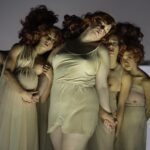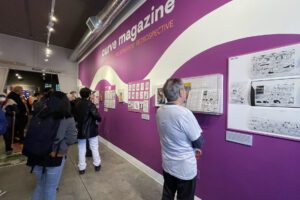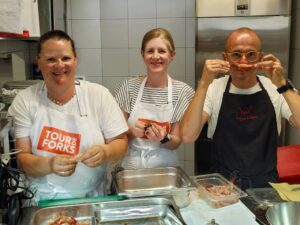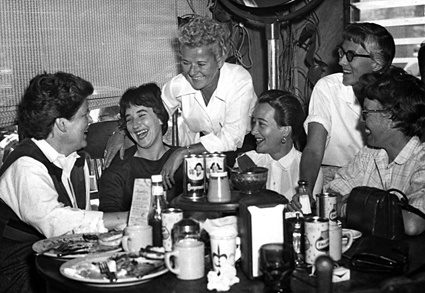
It was the 1940s and there was another great war going on. Men were called off to battle. Women were called to serve on the home front. It was a major shift in gender roles and social mores for the U.S., but somehow little is known about life for LGBTs on the home front during World War II.
The Rosie the Riveter WWII Home Front National Historical Park ( 1414 Harbour Way South, #3000, Richmond; 510-232-5050, email, www.nps.gov/rori) is seeking to rectify that and in the process make history being one of the first U.S. parks to document LGBT history.
An estimated 30 people came out to listen to Elizabeth Tucker, lead park ranger at the park, public historian Donna Graves present “LGBT Hidden Histories on the WWII Home Front,” at the Rosie the Riveter WWII Home Front National Historical Park in Richmond, Calif. on June 14.
The presentation was a part of the launch of the historical project announced in March.
This was the second event reaching out to the community for stories and support. In April, the campaign kicked off with an event at a senior community center in Walnut Creek as a part of the project’s outreach program to find LGBT individuals who lived through or family members and friends who recall stories from that period in U.S. history.
The goal is to produce an exhibit and to build a growing archive of LGBT stories during WWII.
The park was established in 2000 to gather artifacts, information and stories about civilian life during WW II.
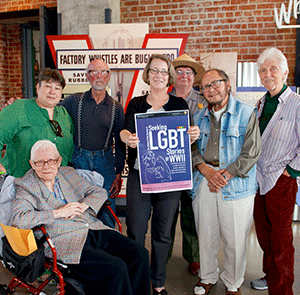

The Greatest Rainbow Generation
While the project is young, the researchers have been able to find three LGBT individuals who served on the home front and overseas at war during the Second World War, who have been present at the events.
A trans man Jeffrey Dickemann, known as Mildred, 85; a lesbian Bev Hickok, 94; and a gay man Selwyn Jones, 92, who shared their stories about being gay in the 1940s and during the war.
Farms needed harvesting and war planes and ships needed to be built.
The war was on. Jeffrey heeded the call. There weren’t any men to harvest the farms, so he followed his sisters from Brooklyn to upstate New York to work on the land during the summer in the 1940s. In spite of his youth, he knew who he was and he suspected that the work was going to attract certain types of women and it did, he being one of them at the time, he told the audience. Jeffrey transitioned to being a man at the age of 65, the oldest to make the transition on record.
One girl was a bit too “rambunctious,” and sent home, Jeffrey says. The incident led to the older girls at the farm to discuss the problem of “homosexuality” among the girls.
“I had never heard anyone discuss what I felt and what I knew,” says Jeffrey, a retired anthropology professor who participated in the project because he hadn’t seen or heard about LGBT stories during WWII in historical accounts until now.
One of the older girls, who was college age, “gave this little talk which she said, ‘It’s just another way of being and it is alright.’”
It changed his life, Jeffrey says.
He’s also participating in a historical project about his war time farm experience for the Regional Oral History Project at the Bancroft Library at the University of California, Berkeley.
It was quite a different experience for Bev.
Bev was a sorority girl at the UC Berkeley who had little interest in finding her future rich husband like the other girls.
Lesbian personal historian and photographer Cathy Cade read from Bev’s autobiography, Against the Current: Coming Out In The 1940’s (Autobiography), about being a living lesbian Rosie the Riveter working on the assembly line at Douglas Aircraft Company in Santa Monica, Calif. in 1942. Bev, who is frail and in a wheelchair, listened in the audience.
Bev’s parents weren’t in favor of their daughter’s working class job, but they allowed it because it was acceptable at the time.
The war served as Bev’s escape out of the privileged world she was raised in and into her life as a lesbian. On the first day on the job, the other gay girls pegged her and invited her to sit with them at lunch. Bev didn’t look back. She went on to join the Women Accepted for Volunteer Emergency Service, better known as WAVES, and became a librarian at UC Berkeley until she retired.


Bev’s wartime experience is one of the few detailed accounts of LGBT civilian life during the war currently available.
Another rare account of LGBT life in the U.S. during WWII was captured in Tina Takemoto, artist and associate professor at the California College of the Arts in San Francisco, documentary, Looking for Jiro, Graves noted. The documentary unearths the story of Jiro Onuma, a gay Japanese man who was incarcerated in Central Utah during WWII.
Saving History
There have been many stories – personal histories and fictionalized – about how World War II liberated women by sending them out into the workforce putting war crafts together as Rosie the Riveters or hitting a home run as female baseball players depicted in A League of Their Own (20th Anniversary Edition) [Blu-ray].
Little has been documented about LGBT life on the home front during WWII and there is now a sense of urgency to gather stories about LGBT life in the 1940’s during the war.
This year marks the 70th anniversary of the end the Second World War. Many of the people who lived through and served in the war are dwindling as the generation is dying.
During the presentation, Donna displayed some of the artifacts she’s been able to obtain through her research at local archives. But firsthand stories and stories from friends and family members, personal documentation from diaries to photographs unearthed from the attic or basement, and more remains to be discovered to piece the larger story of LGBT life during WWII together.
“This is American history. We are a part of American history, so therefore we need our voices to be heard. The only way to do that is if we share those voices with American institutions like the National Park Services that preserve American history,” says Elizabeth, a 47-year-old lesbian.
She couldn’t dream of heading up a project like this and it being supported by the federal government when she first joined the National Park Service nearly 30 years ago.
Jeffrey agrees calling the project “path breaking.”
“Although [Elizabeth] is focused on this one historic monument here in Richmond, it is really a national issue. I think it is incredibly important,” says Jeffrey.
Donna and Elizabeth as well as others also have a sense of urgency to gather these stories and document LGBT life on the home front and WWII.
“There is an urgency, because … only the youngest people from this WWII generation are left,” says Elizabeth.
“Time is running out. These people are in their late 80s and 90s now,” says Therese Ambrosi Smith, a 58-year-old ally and author of the novel Wax, which follows her lesbian protagonist during and after WWII.
Smith is donating the proceeds of sales of [ [ [ Wax[ WAX ] By Smith, Therese Ambrosi ( Author )Aug-01-2011 Paperback to the Rosie the Riveter Trust.
More than $3,000 has been raised from donors and sales of Wax to support the Rosie the Riveter WWII Home Front National Historical ParkLGBT history project and exhibit in 2015, says Marsha Mather-Thrift, executive director of the Trust.
“These are probably some of the most incredible stories from the home front and one of the most stories kept in the dark,” says Marsha, a 67-year-old ally, who hopes that the exhibit will travel to other places. “We are committed to the entire diversity of the home front.”
Donna, a 58-year-old an ally, agrees.
“It feels like its righting a wrong. That for LGBTQ people to have been written out of history and written out of society in many ways – to have been so invisible for so long is a painful and tragic piece of our cultural history,” says Donna, describing that the exhibit “feels like one small piece of the larger effort to achieve equal rights for people who have been marginalized.”
Cathy agreed adding that the new collection is for the LGBT community and anyone who finds it to learn about LGBT culture during WWII in the U.S.
“It’s our history. It’s for us. It’s for the LGBT community to know about people who came before for us, but it’s also for the general public to know that this whole LGBT thing didn’t just happen in the 70s and it’s to get the nitty gritty detail that makes it all human,” says Cathy, who appreciated Bev’s stories about how physically hard the labor was rather than hearing the “romanticized” versions of women’s liberation heading to the factories as Rosie the Riveters.
The Rosie the Riveter WWII Home Front National Historical Park is searching for LGBTs who served and/or were Rosies during World War II to share their stories or any stories people may have about LGBT civilians during WWII for a traveling exhibit in 2015. For more information, call the confidential phone 510-232-5050 x 6631, email
The Rosie the Riveter WWII Home Front National Historical Park, 1414 Harbour Way South, #3000, Richmond. Phone: 510-232-5050. Open daily 10 a.m. – 5 p.m., except on select national holidays. www.nps.gov/rori/Index.htm. Entrance to the museum is free.
To support the Rosie the Riveter WWII Home Front National Historical Park’s LGBT Project, visit the Rosie the Riveter Trust at www.rosietheriveter.org.
Originally published by the Bay Area Reporter.

